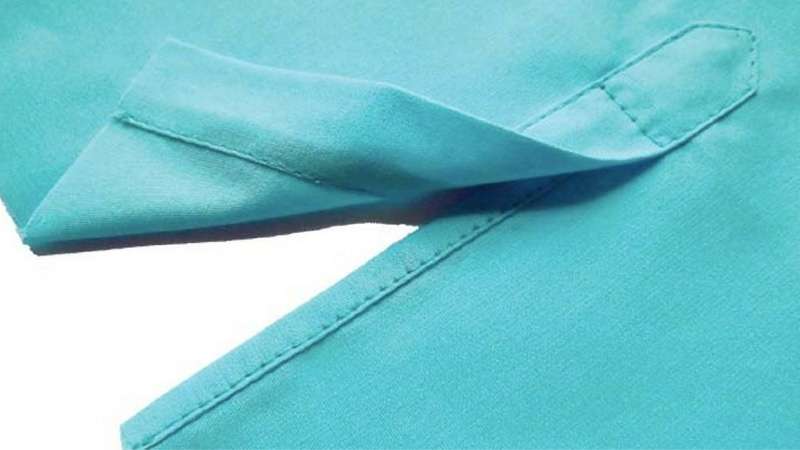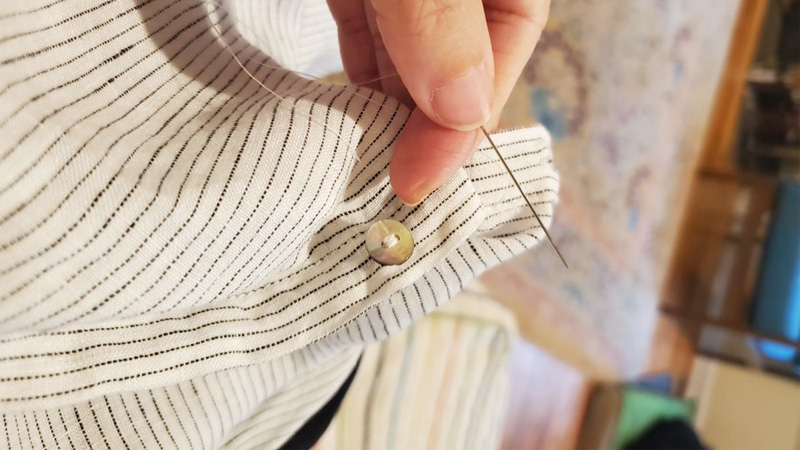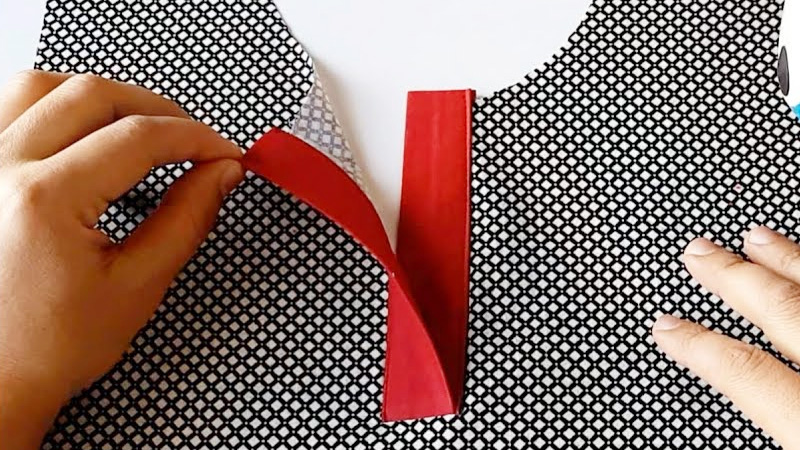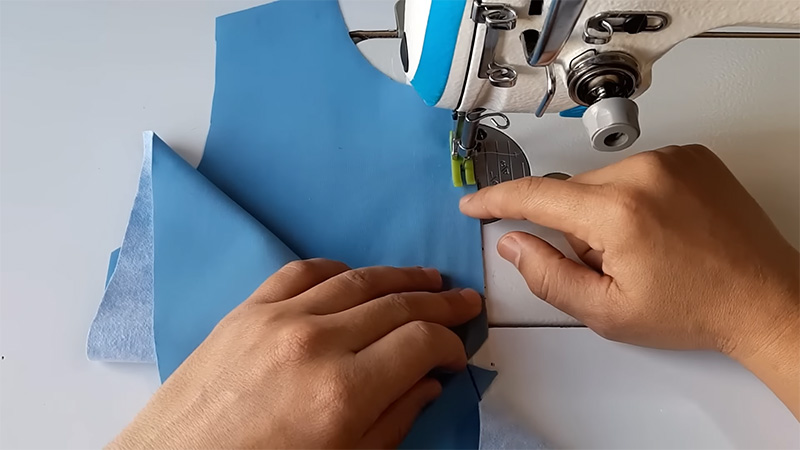Sewing a placket is a fundamental skill in the world of garment construction. Whether you’re a seasoned seamstress or a novice enthusiast, mastering this technique opens up a world of creative possibilities in clothing design.
A placket, essentially a fabric opening or closure, not only serves a practical purpose in facilitating garment wear but also adds aesthetic value to your creations. In this guide, we will delve into the art of sewing a placket, exploring various methods and design ideas that can transform your sewing projects.
From standard button plackets to elegant concealed zippers, you’ll discover the versatility of plackets and how they can elevate the overall look and functionality of your garments.
Whether you’re looking to tailor a classic shirt or add a touch of flair to a dress, this comprehensive guide will equip you with the knowledge and techniques on How to Sew a Placket.

What’s A Placket In Sewing?
In sewing, a placket is a specialized fabric opening or closure technique used in garments, primarily to facilitate putting on and taking off the clothing item.
It typically appears in areas such as the front of shirts, blouses, and dresses, as well as in the cuffs and necklines of certain garments.
Plackets are designed to provide ease of access while maintaining the structural integrity of the fabric. There are several types of plackets, including button plackets and zipper plackets, each with its unique construction method.
Button plackets involve folding and overlapping fabric strips with buttonholes and buttons for closure, while zipper plackets feature a continuous fabric strip with a zipper sewn into it, allowing for a smooth, concealed closure.
Plackets are essential elements in garment construction, ensuring both functionality and aesthetic appeal, as they often serve as decorative features in clothing design.
How To Sew A Placket?

Here are the simple methods for sewing different types of plackets:
Standard Button Placket
A standard button placket is commonly used on shirts and blouses. To create one, you typically cut a strip of fabric that is folded in half lengthwise and then attached to the garment’s edge.
Buttonholes are sewn onto one side of the placket, while buttons are sewn onto the other. The placket is then stitched onto the garment’s front, allowing the buttons to pass through the buttonholes for closure.
Continuous Bound Placket
A continuous bound placket is often used in sleeves and cuffs. It involves cutting a slit in the fabric and then folding and stitching the edges of the slit. A narrow strip of fabric is sewn on top of the folded edges, creating a clean and reinforced opening.
This type of placket is popular for its neat finish and is commonly seen on dress shirts.
Overlap Button Placket
The overlap button placket, as the name suggests, features one side of the fabric overlapping the other. To create it, you sew buttonholes on one side of the placket and buttons on the opposite side.
When worn, the overlapping section with buttonholes is placed on top of the other side, allowing the buttons to pass through the buttonholes for closure.
Centered Zipper Placket
Centered zipper plackets are often used in dresses, skirts, and pants. You cut a slit in the fabric and then attach a zipper tape along the opening’s center. The fabric is folded over the zipper, concealing it, and then stitched in place. This method provides a clean and concealed zipper closure.
Lapped Zipper Placket
Lapped zipper plackets are commonly used in the back of dresses and skirts. You cut a slit in the fabric and then attach the zipper tape beneath the fabric, leaving a small portion exposed. The fabric is then folded over the exposed zipper, creating a clean and secure closure.
Invisible Zipper Placket
Invisible zipper plackets are used for a seamless, concealed closure in garments like formal dresses and skirts. You sew an invisible zipper tape onto the fabric with the teeth facing inward. When zipped up, the zipper becomes virtually invisible, blending seamlessly with the fabric.
Mock Placket (Decorative)
A mock placket is a decorative element often seen on clothing for aesthetic purposes rather than functional closures. It involves creating the appearance of a placket without actual buttons or zippers.
Typically, a strip of fabric is stitched onto the garment, and decorative buttons or snaps may be added for an embellished look.
These seven methods cover a range of placket styles, from practical closures to decorative details, allowing you to choose the one that best suits your sewing project’s needs and design intentions.
Design Ideas To Sew A Placket?

Here are the design ideas to add creative flair to sewing plackets:
Contrast Fabric Placket
A contrast fabric placket is an excellent way to infuse a pop of color or texture into your garment. Instead of using the same fabric as the garment, choose a contrasting fabric for the placket.
This can create a striking visual effect, making the placket a focal point of the design. Consider using a vibrant color, a patterned fabric, or a luxurious texture to make your placket stand out.
Embroidered Placket
Adding embroidery to your placket can be a beautiful and personalized touch. You can embellish the placket with intricate embroidery designs, monograms, or even simple decorative stitches.
Embroidery can elevate the overall look of the garment and give it a unique, handcrafted feel.
Lace or Trim Insert Placket
Incorporating lace or decorative trims into your placket can create a delicate and romantic effect. You can sew lace or trim along the edges of the placket or insert it into the fabric for a peek-a-boo effect.
This design idea works well for blouses, dresses, and lingerie-inspired garments.
Pleated Placket
Pleats add texture and dimension to a placket. You can create pleats along the length of the placket, either on one or both sides.
These pleats can be small and closely spaced for a subtle effect or larger and more dramatic for added visual interest. Pleated plackets work particularly well on shirts and blouses.
Button Tab Placket
A button tab placket is a functional and stylish design element. Instead of sewing buttons directly onto the placket, create small fabric tabs or loops and attach buttons to them.
This creates a unique button closure with a tailored and sophisticated appearance, often seen in tailored jackets and coats.
Faux Fur Placket
Faux fur can add a touch of luxury and warmth to your placket design. Use faux fur fabric to line or trim the placket, creating a cozy and eye-catching detail. This works especially well for outerwear, vests, and winter accessories like scarves and mittens.
Appliqué Placket
Appliqué involves attaching fabric shapes or motifs onto the placket. You can cut out fabric shapes in contrasting colors or patterns and stitch them onto the placket to create intricate designs.
This technique allows for endless creative possibilities, from floral motifs to geometric patterns.
These design ideas offer various ways to enhance your plackets, whether you want to add a touch of elegance, play with texture, or create unique embellishments. Tailoring the placket to suit your project’s style and purpose can truly elevate the overall look of your garment.
Mistakes To Avoid When Sewing A Placket?

Avoiding mistakes when sewing a placket is essential to ensure a clean and functional garment closure.
Here are the common mistakes to watch out for, each described in a paragraph:
Uneven Stitching Lines
One of the most noticeable mistakes is uneven stitching lines along the placket edges. This can happen if you don’t maintain a consistent seam allowance. To avoid this, use sewing guides like markings on your machine’s throat plate, and take your time to sew straight, parallel lines along the placket edges.
Misaligned Buttonholes or Buttons
Misaligned buttonholes or buttons can make your placket look messy and affect its functionality. Always measure and mark the placement of buttonholes accurately, ensuring they align perfectly with the corresponding buttons.
Using a buttonhole foot with your sewing machine can help create precise buttonholes.
Inadequate Reinforcement
Plackets need reinforcement to withstand the stress of frequent use. A common mistake is not reinforcing the areas around buttonholes and buttons adequately. Be sure to interface these areas with lightweight fusible interfacing to provide stability and prevent the fabric from stretching or fraying.
Uneven Folding and Pressing
Achieving neat, even folds is crucial for a polished placket. Failing to fold and press the fabric evenly can result in a messy appearance. Use an iron and a pressing ham to create sharp, uniform folds, following your pattern’s guidelines precisely.
Mismatched Fabric Grain
Plackets require precise fabric grain alignment to maintain the garment’s structure. A mistake to avoid is sewing the placket with fabric that isn’t on-grain. Make sure your fabric’s selvages align with the placket edges, ensuring the fabric doesn’t distort or warp.
Skipping Staystitching
Staystitching along the placket’s edges is often overlooked but essential to prevent stretching or distortion during construction. Skipping staystitching can result in misshapen plackets that don’t lay flat. Always stitch along curved or diagonal edges before proceeding with the placket.
Neglecting to Test the Closure
Before finalizing your placket, it’s crucial to test the closure method (buttoning, zipping, etc.) to ensure it functions smoothly. Neglecting this step can lead to an ill-fitting or non-functional closure, which may require rework. Check the closure multiple times to catch any issues early in the sewing process.
By paying close attention to these common mistakes and taking the necessary precautions, you can ensure that your plackets are well-constructed, visually appealing, and functional additions to your garments.
FAQs
What is a placket in sewing, and why is it important?
A placket is a fabric opening or closure technique in sewing that is crucial for easy dressing and undressing. It allows for secure closures while maintaining the garment’s structural integrity. Plackets are commonly found in areas like shirt fronts, cuffs, and necklines.
What are the basic steps to sew a button placket?
To sew a button placket, you’ll need to create a fabric strip, sew buttonholes on one side, and attach buttons on the other. Carefully align the placket with the garment edge and secure it with precise stitching, ensuring even spacing between buttons and buttonholes.
What is the difference between a lapped zipper placket and a centered zipper placket?
A lapped zipper placket features the zipper tape overlapped by fabric, providing a clean and concealed closure, often used in dresses and skirts. In contrast, a centered zipper placket has the zipper tape placed in the center of a fabric slit, ideal for a clean, symmetrical look.
How can I avoid puckering when sewing a placket?
To prevent puckering, use the correct needle and thread for your fabric, interface the placket area, ensure even tension on your sewing machine, and practice precise stitching. Also, always start with a well-pressed fabric and maintain consistent seam allowances.
Can I add decorative elements to my placket, and how do I do that?
Absolutely! You can embellish plackets with decorative trims, lace, embroidery, or even contrast fabric strips. Simply sew these elements onto the placket during construction, ensuring they complement your garment’s design and add a personalized touch to your creation.
Conclusion
In the world of sewing, mastering the art of sewing a placket is a significant achievement that opens the door to endless possibilities in garment design. Throughout this guide, we’ve explored seven essential methods for sewing plackets, each with its unique characteristics and applications.
From the classic button placket to the elegantly concealed zipper, you now have a toolkit of techniques to enhance your sewing projects. Moreover, we’ve delved into creative design ideas to add flair and personalization to your plackets, making them not only functional but also visually captivating.
Remember that sewing a placket requires precision, attention to detail, and practice. Whether you’re sewing for yourself, loved ones, or clients, a well-executed placket is a testament to your craftsmanship.
Leave a Reply